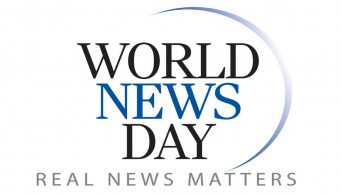World News Day
World News Day: Editors and reporters need to push back against disinformers
The digital age has ushered in an era of unprecedented connectivity, allowing people across the world to share ideas and opinions in almost real time. It has also been characterised by the spread of disinformation.
This is clear when examining nearly all the major issues facing the world today.
For instance, the rise of the Internet and digital technologies brought the promise of greater democratization by providing an unprecedented ability to share information. Today’s reality, however, more resembles the digital dystopia that the World Economic Forum’s Global Risks Report warned of nearly a decade ago. In many countries, online disinformation purposefully created and curated abroad is circulating freely, undermining those countries’ political stability.
Read:World News Day: We’re all entitled to our opinions but not our own facts
Democratic institutions are also coming under pressure as disinformation increasingly fuels polarization and political violence. Today, several countries—including Brazil, Italy, Nigeria and the United States, among others—are warning that disinformation is spreading ahead of important elections.
Meanwhile, digital platforms have enabled us to share expertise and scale solutions to tackle climate change. But too often disinformation derails the discussion. In fact, in the latest Intergovernmental Panel on Climate Change report, the United Nations warned that efforts to curb climate change were being “undermined significantly” by misinformation.
Digital technologies have also supported efforts to combat the COVID-19 pandemic response. This includes the development of infection tracking systems and vaccination delivery. Yet disinformation has come to define the pandemic, too—so much so that the issue was dubbed a so-called infodemic.
The disinformation surrounding these issues and others has soured public discourse and stifled productive dialogues and action. It has also fuelled conspiracy theories.
Take, for example, the conspiracy theory surrounding The Great Reset, a World Economic Forum initiative that promoted the idea of rebuilding economies to be greener and fairer post-COVID-19. Since 2020, state-backed purveyors of disinformation have created and spread deliberate falsehoods about the initiative, often tying it to anti-semitic conspiracy theories about “control” over the global economy.
Read: Survey finds young people follow news, but without much joy
Claims like these are unfounded and are shared without evidence. Nonetheless, they have spread from extremist corners of the internet to the mainstream. The recent account of Russia's disinformation campaign against a US women’s march in 2017 also shows how almost any topic can be targeted. In this case, disinformation was used to inflame divisive culture wars and shift public discourse away from policy-based discussions.
A resurgence of fact-based journalism can help stem disinformation.
Editors and reporters need to push back against politicians and political commentators who bring fringe falsehoods into the mainstream public discourse. Newsrooms should also take care to avoid misleading both-sides-ism. After all, neutrality does not mean abandoning fact-based journalism.
Moreover, fact-based journalism is vital to protecting free speech as disinformation often tarnishes forward-thinking debate. This only serves to slow down progress and undermine efforts to address urgent issues like public health and the climate crisis.
On World News Day, it is important to remember that the disinformers must not be allowed to win.
It is imperative that the free exchange of ideas and opinions proceeds unpoisoned, and that public discourse remains focused on the critical issues facing people all over the world.
3 years ago
World News Day: We’re all entitled to our opinions but not our own facts
Making a positive difference to someone’s life is the greatest gift a journalist can give. Perhaps an individual is heard for the first time, or an injustice is settled.
Those moments when a news editor picks up a phone to hear a scared voice say, ‘you are all I have left, I have nowhere else to turn’. The last stand between hope and defeat.
It is a sacred contract, as old as journalism itself yet the tenor of our times would try to divide the people from the newsrooms. If those who attempt to turn journalists into the enemy are successful, the people’s right to independent access to information will be lost. And as we all know a world where people are blinded from facts is a dangerous one.
During the global pandemic, record audience numbers were reported around the world as readers, viewers and listeners absorbed the news and information that saved lives. Nevertheless, an ever more vociferous minority pedalled a derogatory term, the so-called “mainstream media” – as if being together in a fact-based environment is a bad thing.
Read: Survey finds young people follow news, but without much joy
That’s because the facts can sometimes be uncomfortable, and journalists have a big responsibility to get them right.
We know that since World News Day began in 2018, the challenges facing the industry have only grown. We may better understand the commercial pressures and the ever-changing audience habits, but we still don’t do enough to explain ourselves.
That means newsrooms have their work cut out. Explaining methodology and how facts are uncovered has become as important as the facts themselves.
Those who are potential audience members consume most of their information in closed, fast-paced networks. We have seen examples time and again where small but active minority groups simply believe what they are told, often by powerful forces with something to hide. The journalist is used as bait in an attack against uncomfortable truths. As a result, the industry has to devote more time to reaching those who have already decided the facts even without possessing them.
Read: Philippines affirms news site shutdown order: Maria Ressa
Walled environments exist across the Internet preventing plurality of thought and opinion, fact and reality from being shared. Amid the myriad challenges facing us all, certainty is one of the least attractive traits on display.
World News Day, involving more than 500 newsrooms, is a global initiative aimed at improving media literacy and audience engagement. We include examples of how lives are improved when journalists tell a story. We showcase the efforts of small newsrooms as they represent the importance of community. We underpin all our work with the belief that access to information is a human right.
The speed of change, and the dangers and risks in society sometimes seem only to go in one direction leading to a global audience that is both exhausted and saturated with information. We have constructive roles to play amid the extraordinary news developments.
Read: No point in debating newspapers publishing video content online: Editors' Council
The convening power of independent journalism has never been more important, and sadly because of that hyper-relevance the risks and threats to journalists, your storytellers, only grows. The speed of polarization, an 18th century term used originally to identify the characteristics of light in photography, today makes agreement unfashionable. But as newsrooms around the world often say, we are all entitled to our opinions but we are not entitled to our own facts.
War, economic uncertainty, a determination to run roughshod over generational practices at our institutions are the changes facing the world. Journalism at its best is in the middle of it all, with a role to sew not division but mutual understanding and transparency.
World News Day exists to help the news industry to explain itself better, to involve the global audience in showcasing how accurate information makes life better.
The US president, Joe Biden, was born closer to Abraham Lincoln’s presidency than his own. That perspective shows less the age of the man and more the opportunities and advances that have been taken in the past century, raising with urgency the questions of where we go from here.
About the author:
David Walmsley is the Editor in Chief of the Globe and Mail and is the creator of World News Day.
3 years ago
World News Day observed with focus on climate crisis
Bangladesh on Tuesday joined the global community of journalists in observing the annual World News Day, which aims to promote the importance of authentic journalism.
News organisations and media houses came together across the world on this fourth iteration of World News Day, choosing to highlight the critical importance of credible journalism in providing trustworthy information about the climate crisis and the planet's future.
With the involvement of 500 news organisations across the world, the campaign focuses on one point -- climate change, or as the terminology shifts, the climate crisis -- with 2021 on course to be declared as the hottest year on record amid the worsening consequences of global warming.
The flagship virtual event of this year's campaign is a 75-minute Web show titled “World News Day: The Climate Crisis”.
World News Day is an initiative driven by the Canadian Journalism Foundation and the World Editors Forum to raise awareness about the critical role of journalists in people’s lives. The very first World News Day was observed on September 28, 2018.
Read: Dickson lauds Bangladesh's efforts on climate front
4 years ago
World News Day: How newsrooms made an impact in society
Dhaka, Sep 28 (UNB) - Thirty-eight newsrooms. Forty-seven stories. Making an impact that has been felt far and wide.
6 years ago






